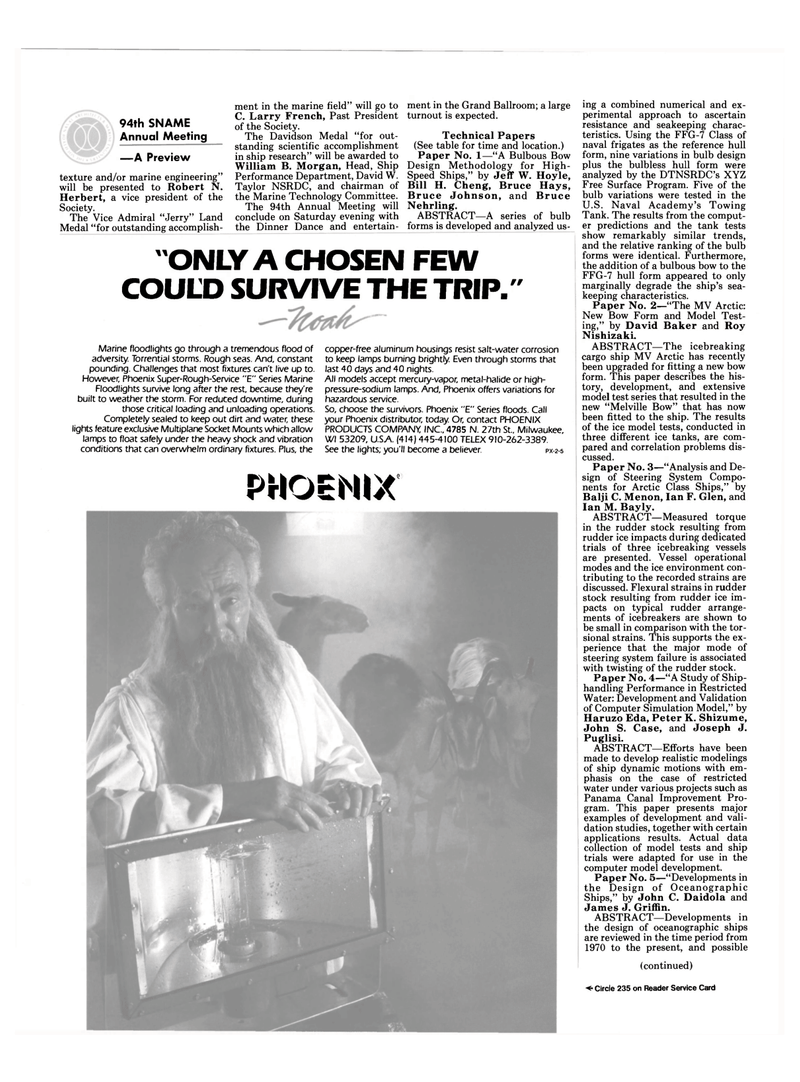
Page 24: of Maritime Reporter Magazine (November 1986)
Read this page in Pdf, Flash or Html5 edition of November 1986 Maritime Reporter Magazine
94th SNAME
Annual Meeting —A Preview texture and/or marine engineering" will be presented to Robert N.
Herbert, a vice president of the
Society.
The Vice Admiral "Jerry" Land
Medal "for outstanding accomplish- ment in the marine field" will go to
C. Larry French, Past President of the Society.
The Davidson Medal "for out- standing scientific accomplishment in ship research" will be awarded to
William B. Morgan, Head, Ship
Performance Department, David W.
Taylor NSRDC, and chairman of the Marine Technology Committee.
The 94th Annual Meeting will conclude on Saturday evening with the Dinner Dance and entertain- ment in the Grand Ballroom; a large turnout is expected.
Technical Papers (See table for time and location.)
Paper No. 1—"A Bulbous Bow
Design Methodology for High-
Speed Ships," by Jeff W. Hoyle,
Bill H. Cheng, Bruce Hays,
Bruce Johnson, and Bruce
Nehrling.
ABSTRACT—A series of bulb forms is developed and analyzed us- "ONLY A CHOSEN FEW
COULD SURVIVE THE TRIP. //
Marine floodlights go through a tremendous flood of adversity. Torrential storms. Rough seas. And, constant pounding. Challenges that most fixtures can't live up to.
However, Phoenix Super-Rough-Service "E" Series Marine
Floodlights survive long after the rest, because they're built to weather the storm. For reduced downtime, during those critical loading and unloading operations.
Completely sealed to keep out dirt and water, these lights feature exclusive Multiplane Socket Mounts which allow lamps to float safely under the heavy shock and vibration conditions that can overwhelm ordinary fixtures. Plus, the copper-free aluminum housings resist salt-water corrosion to keep lamps burning brightly. Even through storms that last 40 days and 40 nights.
All models accept mercury-vapor, metal-halide or high- pressure-sodium lamps. And, Phoenix offers variations for hazardous service.
So, choose the survivors. Phoenix "E" Series floods. Call your Phoenix distributor, today. Or, contact PHOENIX
PRODUCTS COMPANY INC., 4785 N. 27th St., Milwaukee,
Wl 53209, U.SA (414) 445-4100 TELEX 910-262-3389.
See the lights; you'll become a believer. px-2-5
PHOENIX ing a combined numerical and ex- perimental approach to ascertain resistance and seakeeping charac- teristics. Using the FFG-7 Class of naval frigates as the reference hull form, nine variations in bulb design plus the bulbless hull form were analyzed by the DTNSRDC's XYZ
Free Surface Program. Five of the bulb variations were tested in the
U.S. Naval Academy's Towing
Tank. The results from the comput- er predictions and the tank tests show remarkably similar trends, and the relative ranking of the bulb forms were identical. Furthermore, the addition of a bulbous bow to the
FFG-7 hull form appeared to only marginally degrade the ship's sea- keeping characteristics.
Paper No. 2—"The MV Arctic:
New Bow Form and Model Test- ing," by David Baker and Roy
Nishizaki.
ABSTRACT—The icebreaking cargo ship MV Arctic has recently been upgraded for fitting a new bow form. This paper describes the his- tory, development, and extensive model test series that resulted in the new "Melville Bow" that has now been fitted to the ship. The results of the ice model tests, conducted in three different ice tanks, are com- pared and correlation problems dis- cussed.
Paper No. 3—"Analysis and De- sign of Steering System Compo- nents for Arctic Class Ships," by
Balji C. Menon, Ian F. Glen, and
Ian M. Bayly.
ABSTRACT—Measured torque in the rudder stock resulting from rudder ice impacts during dedicated trials of three icebreaking vessels are presented. Vessel operational modes and the ice environment con- tributing to the recorded strains are discussed. Flexural strains in rudder stock resulting from rudder ice im- pacts on typical rudder arrange- ments of icebreakers are shown to be small in comparison with the tor- sional strains. This supports the ex- perience that the major mode of steering system failure is associated with twisting of the rudder stock.
Paper No. 4—"A Study of Ship- handling Performance in Restricted
Water: Development and Validation of Computer Simulation Model," by
Haruzo Eda, Peter K. Shizume,
John S. Case, and Joseph J.
Puglisi.
ABSTRACT—Efforts have been made to develop realistic modelings of ship dynamic motions with em- phasis on the case of restricted water under various projects such as
Panama Canal Improvement Pro- gram. This paper presents major examples of development and vali- dation studies, together with certain applications results. Actual data collection of model tests and ship trials were adapted for use in the computer model development.
Paper No. 5—"Developments in the Design of Oceanographic
Ships," by John C. Daidola and
James J. Griffin.
ABSTRACT—Developments in the design of oceanographic ships are reviewed in the time period from 1970 to the present, and possible (continued) •*• Circle 235 on Reader Service Card

 23
23

 25
25
